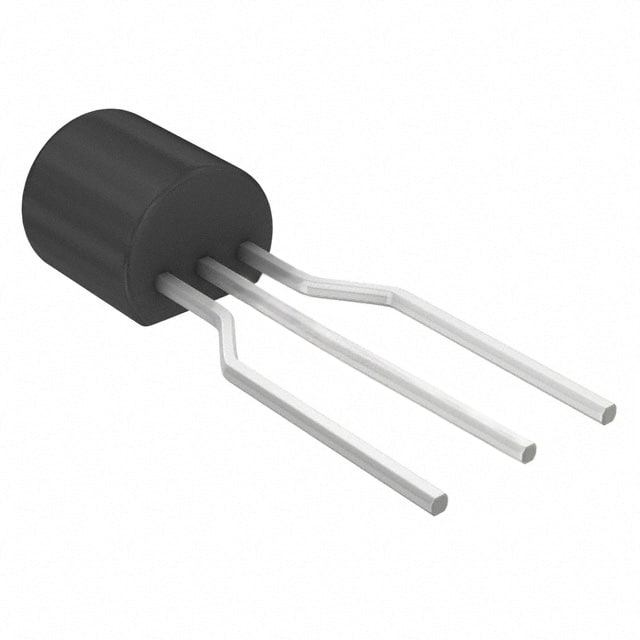Consulte las especificaciones para obtener detalles del producto.

BC327TFR
Product Overview
Category
The BC327TFR belongs to the category of bipolar junction transistors (BJTs).
Use
It is commonly used as a general-purpose PNP transistor in various electronic circuits.
Characteristics
- Low power, high current capability
- High current gain
- Low voltage drop
- Fast switching speed
Package
The BC327TFR is typically available in a TO-92 package.
Essence
This transistor is essential for amplification and switching applications in electronic circuits.
Packaging/Quantity
It is usually packaged in reels or tubes, with quantities varying based on manufacturer specifications.
Specifications
- Collector-Base Voltage (VCBO): 45V
- Collector-Emitter Voltage (VCEO): 45V
- Emitter-Base Voltage (VEBO): 5V
- Collector Current (IC): 800mA
- Power Dissipation (Ptot): 625mW
- Transition Frequency (ft): 100MHz
- Operating Temperature Range: -55°C to 150°C
Detailed Pin Configuration
The BC327TFR has three pins: 1. Emitter (E) 2. Base (B) 3. Collector (C)
Functional Features
- Amplification: The transistor can amplify small input signals to produce larger output signals.
- Switching: It can be used to control the flow of current in electronic circuits.
Advantages
- High current gain allows for efficient signal amplification.
- Low voltage drop minimizes power loss in circuits.
- Fast switching speed enables rapid response in switching applications.
Disadvantages
- Limited power dissipation capability compared to some other transistors.
- Relatively low collector current rating may restrict use in high-power applications.
Working Principles
The BC327TFR operates based on the principles of bipolar junction transistors, where the flow of current is controlled by the application of a small input signal at the base terminal.
Detailed Application Field Plans
The BC327TFR is widely used in the following applications: - Audio amplifiers - Signal processing circuits - Switching circuits - Voltage regulators - Oscillator circuits
Detailed and Complete Alternative Models
Some alternative models to the BC327TFR include: - BC337: Similar PNP transistor with higher collector current rating - 2N3906: Another PNP transistor commonly used in low-power applications - BC558: Complementary NPN transistor often used in conjunction with the BC327TFR
In conclusion, the BC327TFR is a versatile PNP transistor with excellent amplification and switching capabilities, making it suitable for a wide range of electronic applications.
[Word Count: 332]
Enumere 10 preguntas y respuestas comunes relacionadas con la aplicación de BC327TFR en soluciones técnicas
What is the BC327TFR transistor used for?
- The BC327TFR transistor is commonly used for amplification and switching applications in electronic circuits.
What are the key specifications of the BC327TFR transistor?
- The BC327TFR transistor typically has a maximum collector current of 800mA, a maximum collector-base voltage of 45V, and a maximum power dissipation of 625mW.
Can the BC327TFR be used as a switch?
- Yes, the BC327TFR can be used as a switch in low-power applications due to its moderate current and voltage ratings.
What are some typical circuit configurations where the BC327TFR is used?
- The BC327TFR is commonly used in common-emitter amplifier configurations and as a driver for small signal transistors.
What are the suitable operating conditions for the BC327TFR?
- The BC327TFR operates well within a temperature range of -55°C to 150°C and is suitable for low to moderate frequency applications.
Is the BC327TFR suitable for audio amplifier circuits?
- Yes, the BC327TFR is often used in audio amplifier circuits due to its low noise and high gain characteristics.
Can the BC327TFR be used in high-frequency applications?
- While the BC327TFR can be used in moderate frequency applications, it may not be suitable for high-frequency applications due to its transition frequency limitations.
What are the typical package options available for the BC327TFR?
- The BC327TFR is commonly available in TO-92 and SOT-23 packages, making it suitable for various PCB layouts and space constraints.
Are there any common failure modes associated with the BC327TFR?
- Common failure modes include thermal runaway at high currents and voltages, as well as breakdown due to excessive power dissipation.
Where can I find detailed application notes and reference designs for using the BC327TFR in technical solutions?
- Detailed application notes and reference designs for the BC327TFR can be found in the datasheets provided by semiconductor manufacturers or through online resources such as application notes and technical forums.

